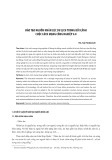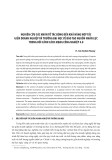
ISSN 1859-1531 - TẠP CHÍ KHOA HỌC VÀ CÔNG NGHỆ - ĐẠI HỌC ĐÀ NẴNG, VOL. 23, NO. 4, 2025 1
CEO TURNOVER AND FIRM PERFORMANCE: EVIDENCE FROM VIETNAM
SỰ THAY ĐỔI Ở VỊ TRÍ GIÁM ĐỐC ĐIỀU HÀNH VÀ LỢI NHUẬN DOANH NGHIỆP:
BẰNG CHỨNG TỪ VIỆT NAM
Vo Thi Thuy Anh, Thai Thi Hong An*
The University of Danang - University of Economics, Vietnam
*Corresponding author: antth@due.edu.vn
(Received: February 04, 2025; Revised: April 11, 2025; Accepted: April 15, 2025)
DOI: 10.31130/ud-jst.2025.183
Abstract - The study aims to explore the impact of Chief
Executive Officer (CEO) turnover on the performance of listed
firms in Vietnam. Using a sample of 513 listed companies from
2010 to 2021, the results show that CEO turnover tends to
reduce corporate profitability. The findings remain consistent
across several robustness tests. We expect that disruptions
caused by CEO turnover lead to changes in strategic priorities,
shake up organizational culture, and make it more difficult for
new CEOs to assert their roles. These factors can negatively
affect firm performance, especially during the transition period,
when profits may decline due to a lack of stability in
management and development orientation.
Tóm tắt - Nghiên cứu nhằm mục đích tìm hiểu rõ về tác động của
sự thay đổi ở vị trí giám đốc điều hành (CEO) đến lợi nhuận của
các công ty niêm yết tại Việt Nam. Sử dụng mẫu bao gồm 513
công ty niêm yết trong giai đoạn từ năm 2010 đến 2021, kết quả
cho thấy sự thay đổi CEO có xu hướng làm suy giảm lợi nhuận
của công ty. Kết quả này vẫn giữ nguyên khi thực hiện các kiểm
định tính bền. Có thể nói, sự gián đoạn do những thay đổi trong
vị trí CEO có thể dẫn đến sự thay đổi trong các ưu tiên chiến lược,
làm biến động văn hóa tổ chức và gây khó khăn cho các CEO mới
trong việc khẳng định vai trò của mình. Những yếu tố này có thể
ảnh hưởng tiêu cực đến hiệu quả hoạt động của công ty, đặc biệt
là trong giai đoạn chuyển giao, khi mà lợi nhuận có thể bị sụt
giảm do thiếu sự ổn định trong quản lý và định hướng phát triển.
Key words - CEO turnover; Firm performance; Resignation;
Designation; Dismissal
Từ khóa - Sự thay đổi trong vị trí giám đốc điều hành; Hiệu quả
hoạt động; Từ chức; Thuyên chuyển; Sa thải
1. Introduction
CEOs play a crucial role in making important strategic
decisions that ultimately determine firm performance ([1],
[2]). Given this significance, CEO turnover and its
influence on various aspects of business operations has
become an increasingly compelling research topic,
particularly in recent years.
Current research has found evidence that CEO turnover
can have both positive and negative impacts on business
operation. While some studies suggest that replacing CEOs
can enhance firm performance, as demonstrated in research
by [3], [4], and [2], other studies such as those by [5] and [6]
argue that changes in these senior leadership positions can
disrupt company stability and create uncertainty, negatively
affecting firm performance. The inconsistent results
regarding the directional impact of CEO turnover on firm
performance may be attributed to sampling issues or other
factors such as the reasons for replacement, experience, or
educational background of the leaders. Therefore, more
empirical research is needed to determine the impact of CEO
turnover on firm performance, especially in emerging
markets like Vietnam, where the topic of corporate
governance characteristics remain underexplored, primarily
due to constraints in relevant data availability. Given this
research gap, additional empirical studies are essential to
provide a foundation for governance decisions, investment
strategies, and macro-level management.
This research was conducted to gain a deeper
understanding of the impact of CEO turnover on the
performance of listed companies in Vietnam, and to
identify which common reasons for CEO turnover have
the most significant influence. Our results indicate that
CEO turnover tends to reduce company profitability,
contradicting the findings of [2] and [4], which suggest
that replacing CEOs leads to positive changes, but
aligning with the results of [6]. The research findings
imply that disruptions caused by CEO turnover lead to
shifts in strategic priorities and organizational culture,
and while newly appointed CEOs require additional time
to become familiar with the new context, these factors can
diminish profits.
This study contributes new evidence to the field of
corporate governance. By analyzing financial data from
listed companies across various industries, the research
provides novel insights into the consequences of CEO
turnover. Additionally, based on the unique dataset, we
focus into analyzing the reasons for CEO turnover,
confirming that among these reasons, the resignation of the
current CEO has the most negative impact on profitability.
The reason is that CEO resignation signals to the market
that the company is facing operational issues that even
those in leadership positions find difficult to improve. Our
research has some implications when showing the
downside of CEO transition processes, particularly for
investors and shareholders who may be overly optimistic
about the outcomes of the turnovers.
The remainder of the paper is organized as follows. In
the next section, theoretical overview and empirical studies
related to the relationship between CEO turnover and firm
performance are presented. Then, the model and data are

2 Vo Thi Thuy Anh, Thai Thi Hong An
showed in section three. Section four is for discussing the
results. Section five concludes the paper.
2. Literature review and hypothesis development
There are two theories that can be used to predict the
relationship between CEO turnover and firm
performance. First, the agency theory by [7] argues that
there is a conflict of interest between shareholders
(the firm owners) and CEOs (their agents), as CEOs may
act in their own interest, potentially harming the long-
term wealth of the owners. Therefore, CEO turnover can
be an effective tool to reduce the conflict of interest
between owners and managers, thereby positively
impacting company performance. Second, stewardship
theory (see [8]) suggests that senior managers are
typically responsible, honest individuals who act in the
company's best interest. According to this theory, we can
predict that CEO replacement might negatively affect
company performance, especially when new CEOs lack
experience in the position or have overconfidence in their
leadership skills.
Recent empirical studies have focused on examining
leadership transitions, primarily the CEO turnover, as a
special factor that can affect many aspects of a company.
However, results on the direction of the relationship
between CEO turnover and firm performance are not
consistent and can be grouped into two major findings.
Most studies in the first group suggest that appointing new
CEOs tends to create a favorable environment for
implementing breakthrough changes in the company,
thereby creating the potential to promote innovation and
enhance future growth. Specifically, [3], based on a data
sample from the UK and Germany, finds that recruiting
new CEOs is effective in realizing significant profit
improvements in subsequent years. They argue that CEO
transition is an important component of successful
transformation in underperforming companies, and this
mechanism is similar in both countries in the observed
sample, despite differences in corporate governance
structure and institutional environment quality between the
two nations.
Similarly, [2] argues that appointing a new CEO can
lead to strategic changes, encouraging the introduction of
innovative processes or products, and delivering
sustainable future growth and development of the
company. However, this study suggests that the positive
impact of CEO turnover on company performance is only
maintained in the short term (first two years) and tends to
diminish over time. Notably, [4], studying a sample of
Italian companies and finds a positive and statistically
significant relationship between CEO turnover and the
ability of a bankrupt company to return to operation. Based
on this evidence, we propose the hypothesis that CEO
turnover can positively impact company performance.
Hypothesis H1a. CEO turnover has a positive impact
on company performance.
However, some studies suggest an unclear, even
negative relationship between CEO turnover and firm
performance. For instance, [5] argues that the dismissal of
CEOs may due to poor management performance of these
directors. In such cases, leadership replacement can be seen
as a mechanism to improve overall performance and
corporate governance effectiveness. However, this study
suggests that a dismissal announcement only brings high
abnormal returns at the time of announcement, rather than
increasing the company's long-term performance.
[6] observes a sample of Japanese companies and finds that
CEO replacement has an inverse relationship with
company performance. [9] suggests that CEO turnover
negatively affects performance in the short term but has no
significant impact on long-term performance. [10] finds
evidence that the shock from CEO turnover reduces
innovation investment. Based on this evidence, we propose
hypothesis H1b as follows:
Hypothesis H1b. CEO turnover has a negative impact
on company performance.
3. Methodology
3.1. Data
The study only includes non-financial firms listed on
two stock exchanges, including the Ho Chi Minh City
Stock Exchange (HOSE) and the Hanoi Stock Exchange
(HNX), during the period from 2010 to 2021. The financial
data is provided by FiinPro database, a reliable financial
data source for the Vietnamese market. Additionally,
information related to boards of directors and CEO
turnover are manually collected based on company annual
reports and verified through publicly available information
on company websites. After cleaning, the final sample of
the study includes a total of 513 companies, with 4,576
observations from 2010 to 2021, which is large enough to
allow detailed analysis of the relationship between firm
performance and CEO changes in the context of the
Vietnamese market.
3.2. Model
To test the relationship between CEO turnover and firm
performance, we use the following model:
Profitabilityi,t
=
β0
+
β1
T
urnoveri,t-1
+
β2 𝑋𝑖,𝑡−1
+
εi,t (1)
Where:
Profitabilityi,t is the profitability of company i in year t,
measured by the ratio of earnings before interest and taxes
to total assets;
Turnover
i,t-1
is a dummy variable that takes the value of
1 if there is a change in the CEO position of company i in
year t-1, and 0 otherwise;
X represents control variables, including firm-level
characteristics, such as firm size (Fsize), sales growth rate
(Sales), tangible assets (Tang), and leverage (Lev), and
other variables reflecting corporate governance
characteristics such as board size (Bsize), duality (Duality),
and independence level (Ind).
Additionally, in the extended model, we control for
CEO characteristics, including education (Edu),
experience (Exp), and tenure (Tenure).

ISSN 1859-1531 - TẠP CHÍ KHOA HỌC VÀ CÔNG NGHỆ - ĐẠI HỌC ĐÀ NẴNG, VOL. 23, NO. 4, 2025 3
Table 1. Measurement of variables
Variables
Measurements
Main variables used in the model
Profitability
Earnings before interest and taxes over total
assets.
Turnover
Dummy variable that takes the value of 1 if there
is a CEO turnover, and 0 otherwise.
Edu
CEo education, that takes the value of 1 if the
CEO holds a degree below bachelor, 2 if bachelor,
and 3 if higher (i.e., master, doctorate).
Exp
The natural logarithm of the number of years
holding a management position from department
level and above.
Tenure
The natural logarithm of the number of years
holding the CEO position.
Bsize
Number of members on the board of directors.
Duality
Dummy variable that takes the value of 1 if the
CEO is also the Chairman, and 0 otherwise.
Ind
Proportion of independent members on the board
of directors.
Fsize
Firm size, calculated as the natural logarithm of
total assets.
Sales
Annual sales growth.
Tang
Fixed assets over total assets.
Lev
Total debts over total assets.
Reasons for CEO turnover
Dismiss
Dummy variable that equals 1 if the CEO is
dismissed and 0 otherwise.
Designate
Dummy variable that equals 1 if the CEO is
appointed to another position and 0 otherwise.
Resign
Dummy variable that equals 1 if the CEO resigns
and 0 otherwise.
Other
Dummy variable that takes 1 if CEO turnover is
due to something other than dismissal/
designation/resignation and 0 otherwise.
Eq. (1) is estimated using the Pooled Ordinary Least
Squares (POLS) method. Besides, to further check the
robustness of findings and control for endogeneity issues,
we use System Generalized Method of Moments (i.e.
system-GMM) to re-estimate the Eq. (1), while also
analyzing subsamples to ensure the reliability of results.
4. Results and discussion
4.1. Descriptive statistics of the research sample
Table 2 presents descriptive statistics of the variables
used in the study. As shown, the average value of the
Profitability is 10.75%. The average debt ratio of
companies is approximately 22.45% of total assets,
indicating that the level of borrowing is not too high.
Additionally, the average annual sales growth rate of firms
is around 11.7%. Tangible assets contribute significantly to
the total assets of firms, with an average ratio of 20.99%.
Regarding governance structure, approximately 16% of
board members are independent members, showing the
presence of independent oversight in the observed
companies. Besides, CEOs of Vietnamese listed firms
mostly hold a bachelor’s degree or higher, reflecting the
relatively high educational level of the leaders in this study.
Table 2. Descriptive statistics
Variables
No. of
Obs.
Mean
Std.
Dev.
Min
Max
Profitability
4,576
0.11
0.09
-0.09
0.42
Exp
4,407
2.57
0.78
0
3.61
Edu
4,407
2.24
0.48
1
3
Tenure
4,407
1.72
0.87
0
3.30
Bsize
4,576
5.52
1.13
3
9
Ind
4,576
0.16
0.22
0
1
Fsize
4,576
27.16
1.53
23.68
31.58
Tang
4,576
0.21
0.20
0
0.86
Sales
4,576
0.12
0.47
-0.71
3.67
Lev
4,576
0.22
0.19
0
0.69
Next, we present the correlation coefficients between
pairs of variables in Table 3. As shown in the table,
there is no serious multicollinearity problem in the model,
since the pairwise correlation coefficients of independent
variables that appear simultaneously in the model do not
exceed 0.8.
Table 3. Correlation matrix
1
2
3
4
5
6
7
8
9
10
11
12
1
Profitability
1
2
Turnover
-0.05a
1
3
Exp
0.13a
-0.15a
1
4
Edu
-0.06a
0.04a
-0.09a
1
5
Tenure
0.04b
-0.46a
0.36a
0.03b
1
6
Duality
0.02
-0.14a
0.23a
-0.07a
0.36a
1
7
Bsize
0.08a
-0.03b
0.08a
-0.02
0.03b
-0.02
1
8
Ind
0.04
0.01
-0.04b
-0.02
-0.02b
-0.01
0.01
1
9
Fsize
-0.03b
0.02
0.02
0.13a
-0.03b
-0.09a
0.29a
-0.01
1
10
Tang
0.41a
-0.04a
0.05a
-0.02
-0.03c
-0.06a
0.15a
0.02c
0.09a
1
11
Sales
0.12a
-0.06a
-0.01
-0.02a
0.01
0.05a
0.04b
0.01
0.06a
0.03b
1
12
Lev
-0.14a
-0.01
-0.05a
0.05a
-0.005
0.01
0.12a
-0.01
0.44a
0.21a
0.06a
1
a, b and c indicate Significance level at 1%, 5% and 10% respectively.

4 Vo Thi Thuy Anh, Thai Thi Hong An
4.2. CEO turnover and firm performance
Table 4 presents the POLS regression results for Eq.
(1) for all firms included in the sample. As shown in
column 1 of Table 4, the regression coefficients of the
Turnover variable are negative and highly statistically
significant at the 1% level, indicating an inverse
relationship between CEO turnover and firm
performance. Specifically, the regression coefficient of
the Turnover variable when regressing for the entire
sample is -0.0125, showing that a change in the CEO
position reduces the profitability by 1.25 percentage
points. This result supports hypothesis H1b.
Next, we perform POLS regression for Eq. (1) while
controlling for additional CEO characteristic variables.
Once again, the regression coefficients of Turnover are
negative. Among the variables measuring CEO
personal characteristics, the Experience has a positive
relationship with Profitability, implying that CEOs
with more experience can drive companies to operate
more efficiently. However, CEOs with higher education
and longer tenure tend to have poorer management
efficiency, reducing the profitability of firms in
the sample.
Since the observed period (i.e., from 2010 to 2021)
includes the COVID-19 time, we re-estimate Eq. (1)
for the period excluding the years 2020 and 2021.
This is to check whether factors associated with the
COVID-19 crisis could be the source of variations in
profitability during this time. As can be seen in columns
3 and 4 of Table 4, in both the basic and extended models,
the regression coefficient of the Turnover variable is
negative and highly statistically significant, implying that
changes in the CEO position lead to lower firm
performance.
Table 4. CEO turnover and firm performance
Full sample
Non-COVID-19
(1)
(2)
(3)
(4)
LTurnover
-0.0125a
-0.0118a
-0.0146a
-0.0173a
(0.0031)
(0.0039)
(0.0037)
(0.0044)
L.Exp
0.0115a
0.0117a
(0.0017)
(0.0020)
L.Edu
-0.0065a
-0.0058b
(0.0023)
(0.0026)
L.Tenure
-0.0053a
-0.0053a
(0.0018)
(0.0020)
L.Duality
-0.0017
-0.0032
-0.0017
-0.0031
(0.0027)
(0.0029)
(0.0030)
(0.0032)
L.Bsize
0.0009
0.0004
0.0005
0.0003
(0.0010)
(0.0011)
(0.0013)
(0.0013)
L.Ind
0.0024
0.0031
0.0047
0.0067
(0.0052)
(0.0053)
(0.0060)
(0.0061)
L.Fsize
0.0043a
0.0042a
0.0051a
0.0049a
(0.0010)
(0.0010)
(0.0012)
(0.0012)
L.Tang
0.1816a
0.1759a
0.1837a
0.1780a
(0.0064)
(0.0065)
(0.0072)
(0.0073)
Full sample
Non-COVID-19
(1)
(2)
(3)
(4)
L.Sales
0.0115a
0.0148a
0.0105a
0.0130a
(0.0029)
(0.0032)
(0.0034)
(0.0036)
L.Lev
-0.1235a
-0.1235a
-0.1318a
-0.1294a
(0.0070)
(0.0071)
(0.0081)
(0.0082)
Constant
0.0087
0.0064
-0.0098
-0.0140
(0.0255)
(0.0260)
(0.0298)
(0.0301)
No of Obs.
4,576
4,407
3,558
3,448
R-squared
0.2412
0.2499
0.2357
0.2456
Year FE
Yes
Yes
Yes
Yes
Industry FE
Yes
Yes
Yes
Yes
Cluster by firm
Yes
Yes
Yes
Yes
Standard errors in parentheses. a, b and c indicate Significance
level at 1%, 5% and 10% respectively.
When delving deeper into the reasons for CEO
turnover, we manually collect four major categories of
reasons, including dismissal, resignation, designation and
other, as shown in the following table.
Table 5. Reasons for CEO turnover
Year
Dismiss
Resign
Designate
Other
2010
8
3
8
13
2011
16
6
8
15
2012
19
10
9
21
2013
16
6
10
23
2014
19
18
9
23
2015
20
21
14
26
2016
20
19
12
22
2017
15
19
8
22
2018
21
16
12
29
2019
36
14
14
32
2020
23
13
35
22
Total
213
145
139
248
Next, Table 6 shows the results of some robustness tests
of the research findings. In columns (1) and (2), we re-
estimate the Eq. (1) using the POLS but replaced the
Turnover with 4 new variables representing the reasons for
changes in the CEO position
As shown in column 1, the coefficients of the
variables of the turnover’s reason are all negative and
statistically significant, indicating an inverse relationship
between CEO transition and firm performance, regardless
of the reason for the change. In column 2, when
controlling for additional CEO characteristics, although
the signs of the regression coefficients of the reason
variables remain negative, only the Resign’s coefficient,
representing CEO resignation, is statistically significant.
This result implies that the event of a current CEO
resigning definitely has the most negative impact on
profitability. This is because CEO resignation sends a
message to the market that the company is facing
seriously operational problems that even the CEOs find
difficult to improve.

ISSN 1859-1531 - TẠP CHÍ KHOA HỌC VÀ CÔNG NGHỆ - ĐẠI HỌC ĐÀ NẴNG, VOL. 23, NO. 4, 2025 5
Table 6. Robustness check
Control for reasons
for CEO turnover
System-GMM
(1)
(2)
(3)
(4)
L.Profit
0.4681a
0.6986a
(0.0363)
(0.0480)
L.Turnover
-0.0076a
-0.0100b
(0.0025)
(0.0050)
L.Dismiss
-0.0119b
-0.0078
(0.0060)
(0.0062)
L.Designate
-0.0118c
-0.0111
(0.0060)
(0.0073)
L.Resign
-0.0306a
-0.0272a
(0.0060)
(0.0073)
L.Other
-0.0019
-0.0037
(0.0050)
(0.0061)
L.Exp
0.0112a
0.00001
(0.0017)
(0.0017)
L.Edu
-0.0064a
-0.0034c
(0.0023)
(0.0019)
L.Tenure
-0.0049a
-0.0021c
(0.0018)
(0.0012)
L.Duality
-0.0015
-0.0031
-0.0029
-0.0040
(0.0027)
(0.0029)
(0.0029)
(0.0033)
L.Bsize
0.0009
0.0005
0.0002
-0.0013
(0.0010)
(0.0011)
(0.0011)
(0.0009)
L.Ind
0.0024
0.0031
0.0073
0.0244a
(0.0052)
(0.0053)
(0.0059)
(0.0089)
L.Fsize
0.0042a
0.0042a
0.0035b
0.0057b
(0.0010)
(0.0010)
(0.0014)
(0.0026)
L.Tang
0.1814a
0.1758a
0.1046a
0.0744a
(0.0064)
(0.0065)
(0.0104)
(0.0161)
L.Sales
0.0114a
0.0147a
0.0098a
0.0109a
(0.0029)
(0.0032)
(0.0020)
(0.0026)
L.Lev
-0.1231a
-0.1233a
-0.0504a
0.0017
(0.0070)
(0.0071)
(0.0093)
(0.0059)
Constant
0.0100
0.0071
0.00001
0.00001
(0.0255)
(0.0260)
(0.00001)
(0.00001)
No of Obs.
4,576
4,407
4,547
4,380
R-squared
0.2431
0.2509
Hansen
0.514
0.328
AR2
0.165
0.071
Year FE
Yes
Yes
Yes
Yes
Industry FE
Yes
Yes
Yes
Yes
Cluster by
firm
Yes
Yes
Yes
Yes
Standard errors in parentheses. a, b and c indicate Significance
level at 1%, 5% and 10% respectively.
Next, we perform regression using the system-GMM
for Eq. (1) both with and without controlling for additional
CEO characteristic. Once again, the regression coefficients
of Turnover are negative and statistically significant,
indicating an inverse relationship between CEO changes
and firm performance. The p-values of the Hansen and
AR2 tests respectively show the validity of the
instrumental variables and confirm the absence of second-
order autocorrelation problem.
In addition, we re-estimate Eq. (1) on two subsamples:
the group of firms where the CEOs are also the Chairman
(dual role) and the group of firms where the CEOs are not
the Chairman (non-dual role). The regression results for
these two subsamples are shown in Table 7.
It can be seen that in both groups, the regression
coefficients of the Turnover variable are consistently
negative and highly statistically significant at the 1% level,
indicating an inverse relationship between changes in
senior leadership positions and operational efficiency.
Notably, the magnitude of the Turnover coefficient is
significantly higher in the dual role group (the regression
coefficients of the Turnover variable in the duality group
are -0.0186 and -0.0265 for the basic and extended models,
respectively, compared to -0.0142 and -0.0115 for the non-
duality group). This result implies that CEO replacement
reduces firm performance, especially when the CEO is
simultaneously the Chairman of the company.
Table 7. Duality vs. non-duality
Duality
Non-duality
(1)
(2)
(3)
(4)
L.Turnover
-0.0186c
-0.0265a
-0.0142a
-0.0115b
(0.0099)
(0.0098)
(0.0036)
(0.0047)
L.Exp
0.0186a
0.0107a
(0.0051)
(0.0020)
L.Edu
-0.0199a
-0.0027
(0.0050)
(0.0028)
L.Tenure
-0.0095b
-0.0036c
(0.0042)
(0.0021)
L.Bsize
-0.0008
-0.0010
0.0007
0.0005
(0.0024)
(0.0024)
(0.0013)
(0.0013)
L.Ind
-0.0080
-0.0077
0.0100
0.0117c
(0.0124)
(0.0125)
(0.0063)
(0.0064)
L.Fsize
0.0084a
0.0088a
0.0038a
0.0036a
(0.0025)
(0.0025)
(0.0012)
(0.0012)
L.Tang
0.1839a
0.1712a
0.1812a
0.1759a
(0.0154)
(0.0158)
(0.0076)
(0.0078)
L.Sales
0.0206a
0.0225a
0.0055c
0.0080b
(0.0064)
(0.0068)
(0.0033)
(0.0036)
L.Lev
-0.1539a
-0.1443a
-0.1199a
-0.1217a
(0.0157)
(0.0159)
(0.0086)
(0.0088)
Constant
-0.0861
-0.0849
0.0210
0.0100
(0.0613)
(0.0639)
(0.0310)
(0.0316)
No of Obs.
1,000
984
3,071
2,943
R-squared
0.2325
0.2627
0.2466
0.2515
Year FE
Yes
Yes
Yes
Yes
Industry FE
Yes
Yes
Yes
Yes
Cluster by
firm
Yes
Yes
Yes
Yes
Standard errors in parentheses. a, b and c indicate Significance
level at 1%, 5% and 10% respectively


























